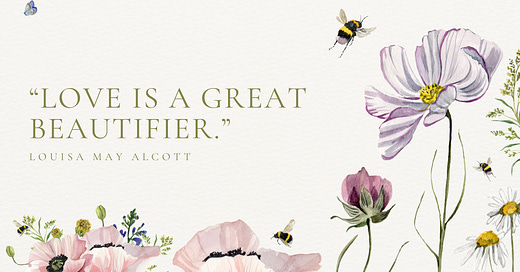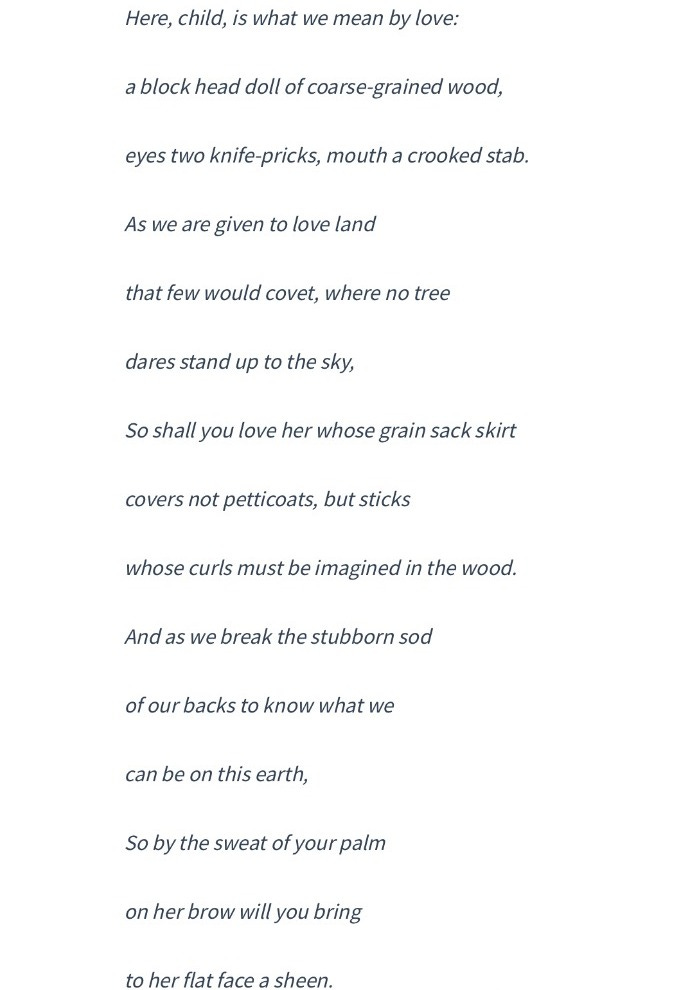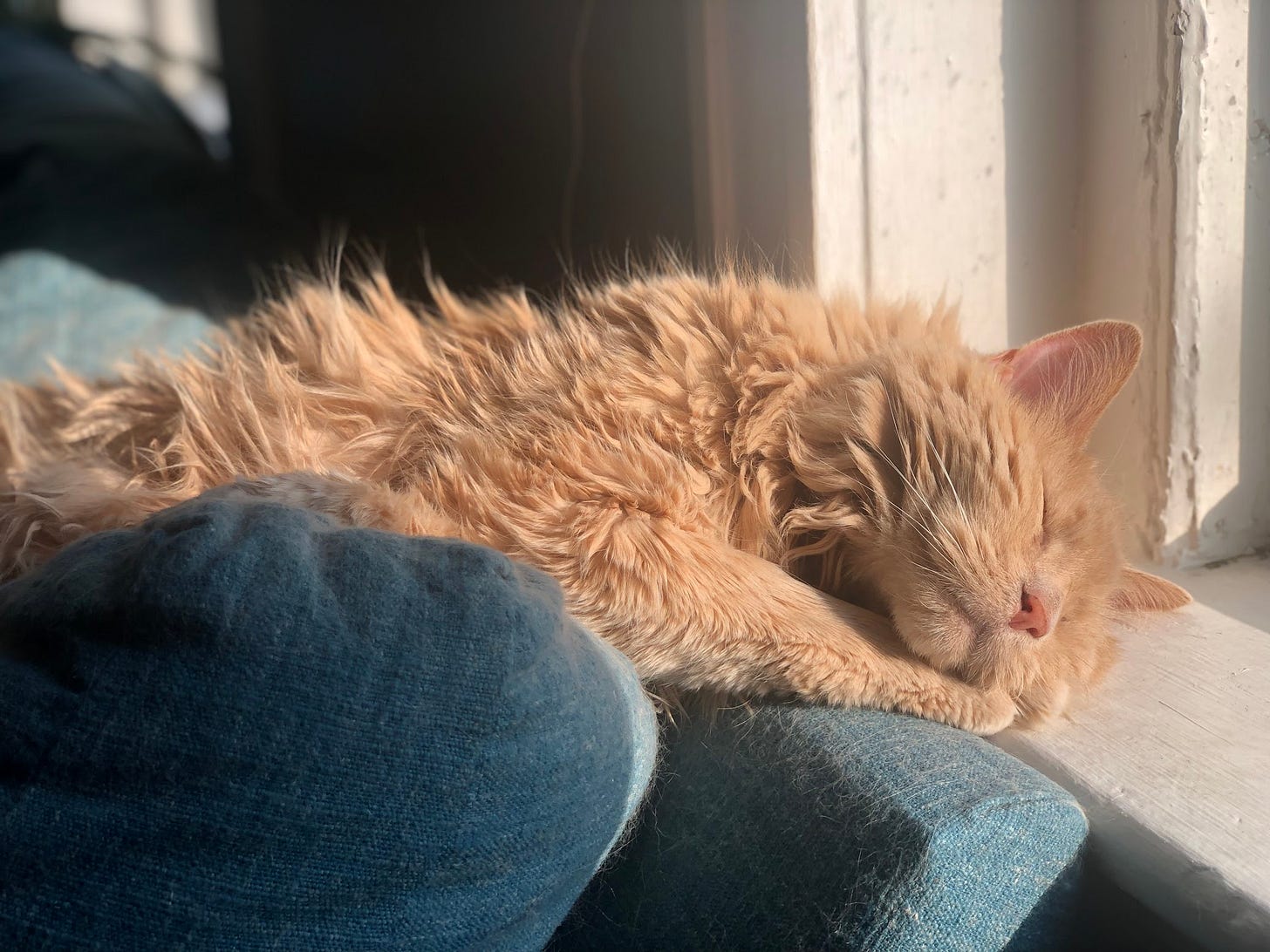My Green Eyes See Only the Blinding Beauty; or Love Like a Cold Compress on a Heart on Fire
A Sunday sermon of sorts
My sister Amanda shared this poem with me earlier this year by Judith Sornberger, just a couple of months before she was preparing to perform a version of it set to music for a faculty recital at Carroll University.
If you are interested in hearing Amanda perform this poem set to music at her recent faculty recital at Carroll University, feel free to watch below; the Pioneer Child’s Doll song begins at 16:09.
I cried as she read the poem to me over the phone. This poem, this poet, was new to me, and arrived smack in the middle of a season where I had been experiencing several weeks of unexplained fatigue, and as a result, a deep sense of defeat and despair. I was literally in bed as she voiced the poem to me across the miles.
When we hung up the phone, she texted me the poem and I immediately copied it by hand into my journal. I wanted the words etched in black ink on the cream colored pages, bound by blue poppies on either side. It felt as if there was so much endlessness in sight that evening, both personal and political, and it’s as if future Melissa sensed she would need some sturdy words in the days and months and years to come to dare her to continue to enter into love, and through such a door, to be able to bestow what she sees with beauty.
In a phenomenological sense, what do you think of when you hear the word “beauty”? What words, images, or sounds does it bring to mind? A dress with pink ruffles and frills and feathers, a la Meg March in Little Women? A deeply burnished sunset in late July, enjoyed whilst your bare feet steady themselves in the sand? A supermodel on the cover of a magazine? The ones you love, resting, breathing, dreaming in the sun or in the deep of the night?
No doubt many factors go into what comes to our minds and hearts when we hear the word “beauty”; the way we are raised, the culture in which we grow up, the social norms, the political pressures, and so much more. We are shaped to define beauty in a certain way, and at the same time, we are called to become aware of this surreptitious (as well as not-so-subtle) sculpting we undergo as humans, and ultimately, to take it into our own hands to fashion a definition of beauty we can live by. We must define beauty for ourselves. And once we do, we must reclaim our right to cultivate it, to notice it, and to uphold its value in all the moments of our lives, however we define it, and wherever we find it.
In my journal for Monday, March 10th of this year I wrote, “I want to create and make and curate beautiful things. Beauty matters.”
I stand by this, still. Sure, some would point out that I used the word “things” and criticize me for being too materialistic (not so). So, go ahead: replace “things” with experiences, poetry, art, theatre, occasions, or a number of other words.
Others might lambaste me for having the audacity to consider the notion of beauty during days that feel like fires raging in our hearts (and forests). These responses are nothing new to me; many people who consider themselves far too mature, smart, aware, and “realistic” tend to think me foolish (at best) and dangerously irresponsible (at worst) for still seeking out the glimmers of beauty that show themselves moment by moment by moment in the current moment, alongside all that is unsteady and sorrowful.
I will not surrender the hope, the sheer joy, the wonder of being alive in this moment for any of these critics. I don’t accept that I’m careless or naive or immature for refusing to relinquish the absolute miracle that it is to be alive. So much of the fuel that drives this engine of ecstasy is beauty.
I still stand by the belief that beauty matters and always will. I am rooted in the notion that the joy we take in making and sharing beauty and enjoying its presence is ours to savor. I believe it matters to seek beauty even in - especially in - the bleakest of times.
Beauty is not extra; it’s essential.
It’s tucked into dusty corners, winking at us if we only dare look it in the eye.
Here are a few things that knocked me out with beauty recently:
Emily Dickinson’s bedroom:
My sweet kitty sleeping in the sun:
This gorgeous new mural by Silvia López Chavez in the Emerson Paramount Center:
Ok, so beauty matters. What now?
I’m fairly good at offering myself steaming cups of earthy herbal tea in my grandmother’s china teacup, hurried inhales of hot pink hyacinths as I power walk to the green line train, and tacking up images and quotes and photos that feed my heart all around the apartment, and yet, Judith Sornberger’s poem doesn’t ask us to find beauty where it’s easily seen. The challenge that Judith Sornberger offers us is different, one with less of a sheen on it.
Like the pioneer child tasked with conjuring the loveliness in a rough-hewn companion, we are often faced with attempting to behold beauty in moments that we didn’t dream up or wish for, or in circumstances that will not change.
What happens when we can’t choose what is given to us? When we don’t have the privilege to choose where we live, what work we do, or the very real limitations we experience physically?
What do we do when there is not much to be found that could be called beautiful? When we crave a gorgeous mouth and find only a “crooked stab” instead?
What about illness? Death? What about the panic that pokes into our bellies at night, keeping golden sleep from reigning? What about a sense of things falling to pieces, and us powerless to keep them together?
Lost jobs.
Being evicted from a home we cherish.
Relationships shifting speeds and senses of certainty fading into yesterdays.
The make-do version of the million dollar dream we worked towards for so long that doesn’t feel like enough.
How do we settle for splinters when what we craved was smooth and soft and stable?
An invitation to see the beauty in the blankness is all well and good in a poetry sense, but what about real life? What about the moments when we, dreaming of a lush paradise, “are given to love land / that few would covet?'“ What do we do then? Where do we go?
What if being willing to seek the beauty, the wonder, the possibility in what “must be imagined in the wood,” does not need equate with denial or toxic positivity, but instead involve a dedicated practice of love, carefully and consistently applied to the wood grain of our own lives, again and again and again - forever?
When I was young, I was obsessed with the idea of having an apartment, like Stacey from The Babysitters Club did when she grew up in New York City. Even at the age of eight years old, I was determined to turn my bedroom into my own “apartment”, and the pièce de résistance was to be my very own coffee table, complete with magazines on top to match.
I’m sure I asked my mom for a coffee table at some point during this quest, and having no spare coffee table to give a child for their room and without the money to go out and buy one, we came up with a compromise: a large cardboard box turned upside down. I put magazines on top and a cup of water masquerading as a cup of coffee, and can I tell you? My coffee table was the BEST. It mattered not that it had flimsy worn cardboard sides; in my mind’s eye, I saw the richest dark wood that shined as if I had polished it with Pledge. No way to sit in front of the coffee table without my knees bumping into the box, jeopardizing my previously mentioned cup of “coffee”, but did I care? Not one bit! I sat side saddle on a tiny chair, legs crossed, feeling fancier than ever before. I had a gorgeous coffee table, one that had the power to attract the most fascinating of guests (including a few imaginary friends at the time). I suspect it’s possible that my cardboard coffee table was more beloved in my eyes than the most expensive department store one might find installed in a mansion. What more could I want?
I don’t share this to say that I had superpowers or that I was superior in some way. Quite the opposite. I was simply being a kid, using my innate imagination to make real the dreams I had swirling around in my head and heart. I was also (without having the language for it) practicing love, a lens through which we can always look and discern the energetic essential beauty of an object, a person, a place, or an experience in any given moment. How wise we can be as children, and how satisfied we can be if we continue to practice the craft of love as adults.
When we apply love, it colors everything.
Love transforms my Grandma and Papa’s worn blue and yellow striped tablecloth from the 1960’s into fabric fit for a feast.
Love elevates a simple meal of leftover rice and miscellaneous stir-fry vegetables served in chipped china into a spiritual shared experience between loved ones, across generations and the doorways of death.
Love lets my dad’s faded white cotton shirt that he wore on his honeymoon to Hawaii shine with the stories woven within, and when I wear it, I don’t notice the small pull of fabric on the chest, or if I do, I can see how lovely it is to be granted a chance to be kept company by a piece of clothing that once allowed my dad to savor the crystal blue waters of a Honolulu beach at dusk and sheltered him into a new chapter of his life as a husband, and eventually my dad.
Others might discard these items as old, insignificant, and unwanted. Because of the love I apply to them and imbue them with, my green eyes see only the blinding beauty, hidden in plain sight. I am so lucky to be a steward of such unassuming preciousness.
As Louisa May Alcott so wisely wrote, “Love is a great beautifier.”
Love allows us to see. To be grateful. To build the life we are building, board by board, and appreciate it for the gorgeous masterpiece that it is, a life well loved, regardless of the materials we have at our disposal. There is nothing more beautiful than being in love with the lives we are making, imperfect and winding and rough as they are. There is nothing that could compare to the magic that the “sweat of our palm” can bring, no matter how new, shiny, or novel.
So, we can see the beauty in the worn, the weary, the wonky. What now?
I’m not going to pretend I have any answers to how we might walk the road of heartache and injustice and unspeakable suffering and simply swear that we see beauty. For the moments that test the very strength of our bones, how can love remain the lens through which we might get a glimpse of what it is we truly desire: beauty, comfort, peace?
I don’t have answers. I have questions, and I’ll share them with you here in hopes that they might ignite your imagination as I hope they do mine. I do believe that by dreaming of “what might” be, we might unearth the ability to survive and even thrive in the “what is.”
When there is no outward beauty to be found, and we flounder trying to even imagine anything that could be deemed beautiful, comforting, or peaceful, can we consider our own beauty as human beings, defined by our ability to be in the middle of the discomfort, the less than gorgeous, the keenly sharp, the uncertainty?
What if we can call out the grotesque and still see the gloriousness in the act of raising of our own, cracked voice? Of hearing others open their mouths as well, of joining together in an off-key chorus of “We are wounded, we won’t give up, we don’t know how, yet we will keep going”? Can beauty be seen in these acts?
When one of us cannot see the beauty or is struggling to apply love like a cold compress on a heart on fire, can we step into those spaces, and sit in the sting, in the strain, in the stuntedness? Can we let the pain register, not rush the transmutation, and ultimately meet the moment with love until beneath the surface, we begin to see a shimmer of something like beauty?
Now, we have come full circle; back to beauty. Where do you see beauty in this moment? Look around. Feel what’s under your feet, see what’s above your head - maybe it’s a hardwood floor or a soft dusky sky. What makes your skin prickle with wonder, with mystery, with a sense that we are all connected, always?
Leaving you all with a poem I composed five years ago this week. We underestimate poetry. Like beauty, so many people put it off as flighty and floaty, a hot air balloon in the clouds, pretty but petty, and certainly not applicable for any kind of “real” support we could use to stead ourselves.
Yet.
We poets want you to take our words and lean into them, rest in them, pick them up up like swords to fight for your souls, every, every day. We deserve to start to see poetry as nourishment for our hardest hours. Let poetry slake your thirst. Let poetry feed you.
(As always, I hope you read something you love.)
Untitled Poem, April 14th, 2020
When the tears of rage begin
to prickle your heart
and there lies a brick behind your eyes,
separating your sight from your mind,
I pray, now and always,
that you give yourself over to the tide.
Let it rush in
and soak all the heaviness you carry.
And I wish you strength
to sit with it while it steeps your heart,
for if you can endure when (not if)
it goes,
it shall rush away,
and with it,
your whole body will soften,
relinquishing all the sadness you had
soaked up like a sponge.
Let yourself be wrung out
for only when you have emptied your heart and eyes
of everything you have in this moment
can there be empty space for you to fill
with all the joy
you will seek
and save
and savor
in the Somewhere
beyond the Now.








